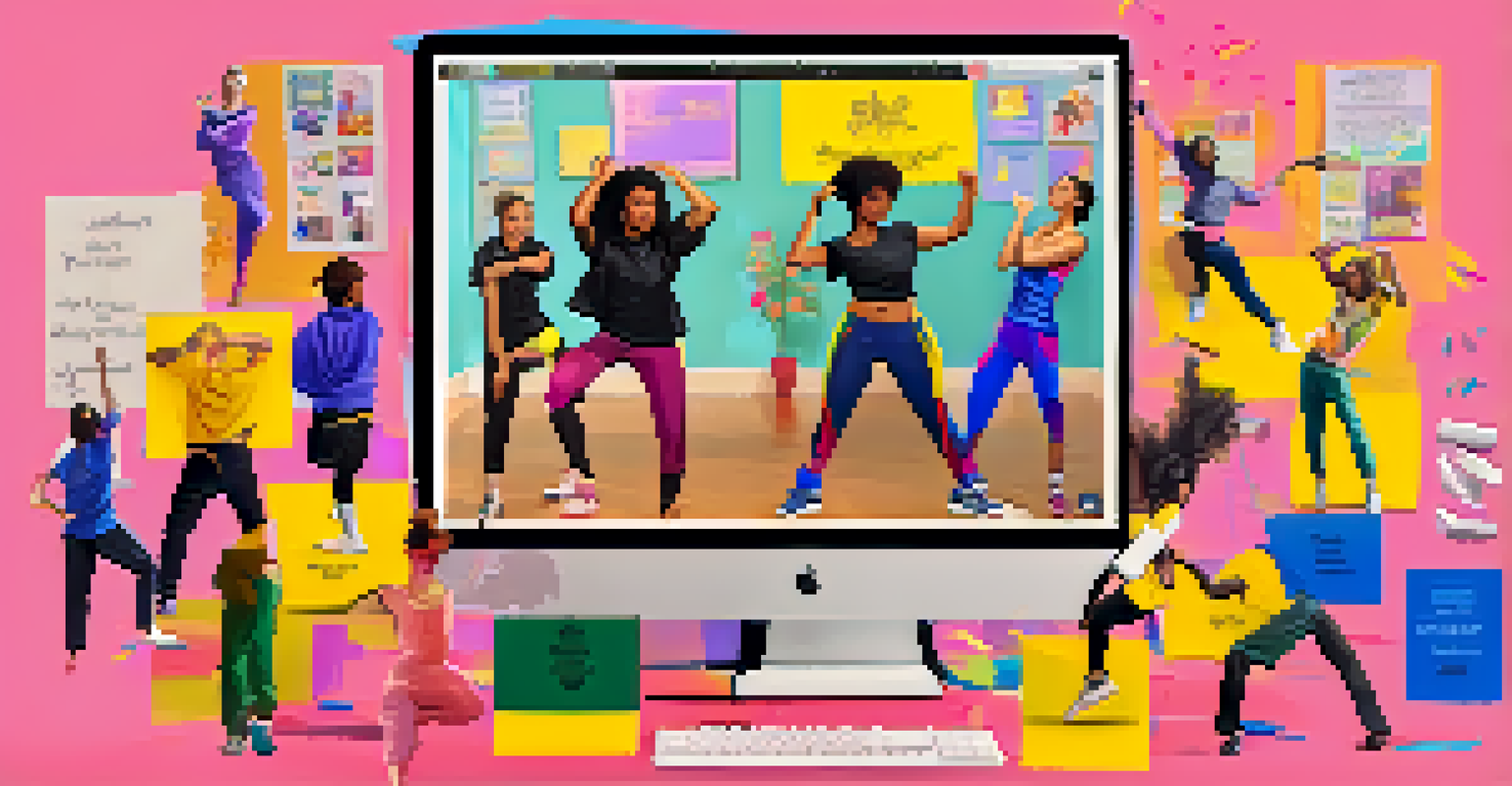Online Dance Classes: Technology's Impact on Learning Dance

The Rise of Online Dance Classes in the Digital Age
In recent years, online dance classes have surged in popularity, largely due to advancements in technology. With platforms like Zoom and YouTube, dancers can now learn from the comfort of their homes. This accessibility has opened doors for people who may not have had the chance to attend traditional dance studios.
Dance is the hidden language of the soul.
The convenience of online classes means that you can fit dance into your busy schedule, whether it's early in the morning or late at night. No more worrying about commuting or fitting your lessons around studio hours. This flexibility allows dancers of all levels to pursue their passion without the constraints of time or location.
Additionally, the variety of styles and instructors available online is staggering. From ballet to hip-hop, anyone can find classes that suit their interests and skill levels. This explosion of options fosters a vibrant community where dancers can explore new forms of expression.
Technology Enhances Learning: Tools and Platforms
The tools and platforms available for online dance classes play a significant role in enhancing the learning experience. Video conferencing platforms allow for real-time feedback from instructors, creating an interactive environment. Dancers can receive immediate corrections and encouragement, which is crucial for skill development.

Moreover, recorded sessions enable students to revisit lessons at their own pace. This feature is particularly beneficial for mastering complex choreography or refining technique. Being able to pause, rewind, and practice as many times as needed can lead to deeper understanding and retention of skills.
Online Dance Classes Offer Flexibility
The rise of online dance classes allows individuals to learn at their own pace and on their own schedule, breaking the constraints of traditional studio hours.
Social media also plays a part in this digital dance revolution. Platforms like Instagram and TikTok allow dancers to share their progress, connect with peers, and find inspiration. This sense of community can motivate individuals to stay committed to their dance journey.
The Role of Community in Online Dance Classes
One of the most significant aspects of dance is the sense of community it fosters. Even in an online format, dance classes can create a supportive environment where participants feel connected. Many classes incorporate group discussions, encouraging dancers to share their experiences and tips.
The only way to make sense out of change is to plunge into it, move with it, and join the dance.
In addition, online dance studios often host virtual events or showcases, allowing students to perform for their peers. This not only boosts confidence but also builds camaraderie among dancers. Sharing achievements, no matter how small, nurtures a sense of belonging.
The ability to communicate with others who share your passion, even from afar, can be incredibly uplifting. Online forums and social media groups can further enrich this experience, offering a space for dancers to connect, collaborate, and celebrate each other's successes.
Challenges of Learning Dance Online
Despite the numerous benefits, online dance classes come with their own set of challenges. A common issue is the lack of physical space; not everyone has a large area to practice, which can limit movement. This constraint may hinder students from fully engaging in certain dance styles that require more room.
Another challenge is the reliance on technology, which can sometimes lead to technical difficulties. Poor internet connections or malfunctioning devices can disrupt a class, leading to frustration. It's essential for both instructors and students to be prepared for these potential hiccups.
Community Thrives in Virtual Settings
Despite being online, dance classes foster a sense of community through group discussions, virtual events, and social media connections.
Finally, the absence of in-person interaction can make it harder for some dancers to stay motivated. While the online community is supportive, it might not replace the energy and encouragement found in a live class setting. Finding ways to stay engaged and inspired is crucial for a successful online dance journey.
Incorporating Personalization in Online Dance Learning
One of the advantages of online dance classes is the ability to personalize learning experiences. Many instructors now offer tailored lessons that cater to individual needs and goals. This customization helps dancers focus on specific areas they want to improve, enhancing their overall development.
Additionally, some platforms allow students to choose their learning pace. Whether you prefer to take it slow or dive into advanced techniques, online classes can accommodate your unique preferences. This flexibility makes dance accessible to a broader range of learners.
Furthermore, feedback can be more personalized in online settings. Instructors can provide individualized video critiques or one-on-one sessions to address specific challenges. This targeted approach can lead to significant advancements in a dancer's skill set.
The Future of Dance Education: Blending Online and In-Person
As we move forward, the future of dance education seems to be a blend of online and in-person experiences. The convenience of online classes paired with the energy of live sessions can create a comprehensive learning environment. Many studios are already exploring hybrid models to offer the best of both worlds.
This combination allows students to enjoy the flexibility of online classes while benefiting from the community and hands-on instruction offered in traditional settings. Imagine starting a class online, then transitioning to in-person workshops to refine skills—an enticing prospect for many dancers.
Personalization Enhances Learning
Online platforms enable tailored lessons and individualized feedback, allowing dancers to focus on specific skills and progress at their own pace.
Moreover, this hybrid approach can attract a wider audience. Those who may have hesitated to join a dance studio due to distance or time constraints can now engage in both formats. This evolution in dance education will likely continue to inspire and empower dancers for years to come.
Final Thoughts: Embracing the Digital Dance Revolution
Online dance classes have undeniably transformed the way we learn and engage with dance. While traditional studios hold their charm, the digital landscape offers unique opportunities for growth and connection. Embracing this shift can lead to a richer dance experience.
As technology continues to evolve, so too will the methods of dance education. Staying open to new possibilities can enhance not only your skills but also your love for dance. Whether you're a beginner or an advanced dancer, there’s a place for you in this digital dance community.

Ultimately, the key is to find what works best for you. Explore different platforms, connect with instructors, and don’t hesitate to share your journey. With technology at our fingertips, the world of dance is more accessible than ever—so put on your dancing shoes and join the revolution!